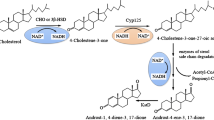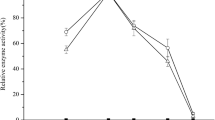Abstract
Cyclodextrins (CDs) can improve productivity in the biotransformation of steroids by increasing conversion rate, conversion ratio, or substrate concentration. However, little is known of the proportion of products formed by multi-catabolic enzymes, e.g., via sterol side chain cleavage. Using three strains with different androst-1,4-diene-3,17-dione (ADD) to androst-4-ene-3,17-dione (AD) ratios, Mycobacterium neoaurum TCCC 11028 (MNR), M. neoaurum TCCC 11028 M1 (MNR M1), and M. neoaurum TCCC 11028 M3 (MNR M3), we found that hydroxypropyl-β-cyclodextrin (HP-β-CD) can appreciably increase the ratio of ADD to AD, the reaction rate, and the molar conversion. In the presence of HP-β-CD, conversion of 0.5 g/L of phytosterol (PS) was 2.4, 2.4, and 2.3 times higher in the MNR, MNR M1, and MNR M3 systems, respectively, than in the controls. The ADD proportion increased by 38.4, 61.5, and 5.9 % compared with the control experiment, which resulted in a strong shift in the ADD/AD ratio in the ADD direction. Our results imply that the three PS-biotransforming strains cause efficient side chain degradation of PS, and the increased conversion of PS when using HP-β-CD may be associated with the higher PS concentration in each case. A similar solubilizing effect may not induce a prominent influence on the ADD/AD ratio. However, the different activities of the Δ1-dehydrogenase of PS-biotransforming strains result in different incremental percentage yields of ADD and ADD/AD ratio in the presence of HP-β-CD.


Similar content being viewed by others
References
Bie ST, Lu FP, Du LX, Qiu Q, Zhang Y (2008) Effect of phase composition on the bioconversion of methyltestosterone in a biphasic system. J Mol Catal B Enzym 55:1–5
Carvalho F, Marques MPC, de Carvalho CCCR, Cabral JMS, Fernandes P (2009) Sitosterol bioconversion with resting cells in liquid polymer based systems. Bioresource Technol 100:4050–4053
Chincholkar SB, Sukhodol’skaya GV, Baklashova TG (1992) Peculiaritie of the 11β-hydroxylation of steroid compounds by the mycelium of Gurvularia lunata VKMF 644 in the presence of β-cyclodextrin. Prikl Biokhim Microbiol 28(7):685–693
Cruz A, Fernandes P, Cabral JMS (2002) Effect of phase composition on the whole-cell bioconversion of β-sitosterol in biphasic media. J Mol Catal B Enzym 19(2):371–375
Donova MV, Nikolayeva VM, Dovbnya DV, Gulevskaya SA, Suzina NE (2007) Methyl-β-cyclodextrin alters growth, activity and cell envelope features of sterol-transforming mycobacteria. Microbiology 153:1981–1992
Egorova OV, Gulevskaya SA, Puntus IF, Filonov AE, Donova MV (2002) Production of androstenedione using mutants of Mycobacterium sp. J Chem Technol Biotechnol 77:141–147
Egorova OV, Nikolayeva VM, Sukhodolskaya GV, Donova MV (2009) Transformation of C19-steroids and testosterone production by sterol-transforming strains of Mycobacterium spp. J Mol Catal B Enzym 57:198–203
Fernandes P, Cruz A, Angelova B, Pinheiro HM, Cabral JMS (2003) Microbial conversion of steroid compounds: recent developments. Enzyme Microb Technol 32:688–705
Garai S, Banerjee S, Mahato SB (1995) Selective 1-dehydrogenation of progesterone by Aspergillus fumigatus. J Chem Res Synop (10):408–409
Gould S, Scott RC (2005) 2-Hydroxypropyl-beta-cyclodextrin (HP-beta-CD): a toxicology review. Food Chem Toxicol 43(10):1451–1459
Hesselink PGM, Vliet SV, Vries HO (1989) Optimication of steroid side chain cleavage by cyclodextrins. Enzyme Microb Technol 11:398–404
Lu W, Du L, Wang M, Guo Y, Lu F, Sun B, Wen J, Jia X (2007) A novel substrate addition mode in the 11β-hydroxylation of steroids by Curvularia lunata. Food Bioprod Process 85(C1):1–11
Ma YH, Wang M, Fan Z, Shen YB, Zhang LT (2009) The influence of host-guest inclusion complex formation on the biotransformation of cortisone acetate Δ1-dehydrogenation. J Steroid Biochem 117(4–5):146–151
Malaviya A, Gomes J (2008) Enhanced biotransformation of sitosterol to androstenedione by Mycobacterium sp. using cell wall permeabilizing antibiotics. J Ind Microbiol Biotechnol 35:1235–1239
Manosroi A, Saowakhon S, Manosroi J (2008) Enhancement of 17α-hydroxyprogesterone production from progesterone by biotransformation using hydroxypropyl-β-cyclodextrin complexation technique. J Steroid Biochem 108:132–136
Manosroi A, Saowakhon S, Manosroi J (2007) Enhancement of and rostadienedione production from progesterone by biotransformation using the hydroxypropyl-β-cyclodextrin complexation technique. J Steroid Biochem 30(1):1–5
Perez C, Falero A, Llanes N, Hung BR, Hervé ME, Palmero A, Martí E (2003) Resistance to androstanes as an approach for androstandienedione yield enhancement in industrial mycobacteria. J Ind Microbiol Biotechnol 30:623–626
Roglic U, Plazl P, Plazl I (2005) The influence of β-cyclodextrin on the kinetics of progesterone transformation by Rhizopus nigricans. Biocatal Biotransfor 9(5):299–305
Rumijowska A, Lisowska K, Ziolkowski A, Sedlaczek L (1997) Transformation of sterols by Mycobacterium vaccae: effects of lecithin on the permeability of cell envelopes to sterols. World J Microbiol Biotechnol 13:89–95
Schlosser D, Irrgang S, Schmauder HP (1993) Steroid hydroxylation with free and immobilized cells of Penicillium raistrickii in the presence of β-cyclodextrin. Appl Microbiol Biotechnol 39(1):16–20
Shen YB, Wang M, Zhang LT, Ma YH, Ma B, Zheng Y, Liu H, Luo JM (2011) Effects of hydroxypropyl-β-cyclodextrin on cell growth, activity, and integrity of steroid-transforming Arthrobacter simplex and Mycobacterium neoaurum. Appl Microbiol Biotechnol 90:1995–2003
Smith M, Zahnley J, Pfeifer D, Goff D (1993) Growth and cholesterol oxidation by Mycobacterium species in Tween 80 medium. Appl Environ Microbiol 59:1425–1429
Szentirrnai A (1990) Microbial physiology of side-chain degradation of sterols. J Ind Microbiol 6:101–116
Wang M, Zhang LT, Shen YB, Ma YH, Zheng Y, Luo JM (2009) Effects of hydroxypropyl-β-cyclodextrin on steroids 1-en-dehydrogenation biotransformation by Arthrobacter simplex TCCC 11037. J Mol Catal B Enzym 59:58–63
Wang Z, Xu JH, Chen D (2008) Whole cell microbial transformation in cloud point system. J Ind Microbiol Biotechnol 35:645–656
Wang Z, Zhao F, Chen D, Dao D (2006) Biotransformation of phytosterol to produce androsta-diene-dione by resting cells of Mycobacterium in cloud point system. Process Biochem 41:557–561
Wang ZF, Huang YL, Rathman JF, Yang ST (2002) Lecithin-enhanced biotransformation of cholesterol to androsta-1,4-diene-3,17-dione and androsta-4-ene-3,17-dione. J Chem Technol Biotechnol 77:1349–1357
Wei W, Wang FQ, Fan SY, Wei DZ (2010) Inactivation and augmentation of the primary 3-ketosteroid-delta(1)-dehydrogenase in Mycobacterium neoaurum NwIB-01: biotransformation of soybean phytosterols to 4-androstene-3,17-dione or 1,4-androstadiene-3,17-dione. Appl Environ Microbiol 76(13):4578–4582
Zhang LT, Wang M, Shen YB, Ma YH, Luo JM (2009) Improvement of steroid biotransformation with hydroxypropyl-β-cyclodextrin induced complexation. Appl Biochem Biotech 159(3):642–654
Acknowledgments
This work was supported by the National Natural Science Foundation of China (no. 21076158), the Program for New Century Excellent Talents in University (no. NCET-08-0911), the National High Technology Research and Development of China (2011AA02A211), and the Foundation for Excellent Doctoral Dissertations of TianJin University of Science and Technology in 2010 (no. B201001).
Author information
Authors and Affiliations
Corresponding author
Rights and permissions
About this article
Cite this article
Shen, YB., Wang, M., Li, HN. et al. Influence of hydroxypropyl-β-cyclodextrin on phytosterol biotransformation by different strains of Mycobacterium neoaurum . J Ind Microbiol Biotechnol 39, 1253–1259 (2012). https://doi.org/10.1007/s10295-012-1130-0
Received:
Accepted:
Published:
Issue Date:
DOI: https://doi.org/10.1007/s10295-012-1130-0




